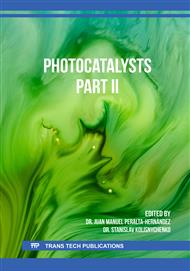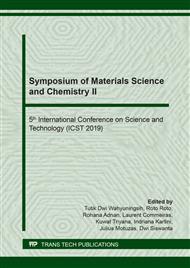p.424
p.430
p.441
p.448
p.454
p.459
p.466
p.472
p.478
Synthesis of Fe3O4/TiO2 Nanocomposite as Photocatalyst in Photoreduction Reaction of CO2 Conversion to Methanol
Abstract:
TiO2 modified Fe3O4 nanocomposite as photocatalyst in CO2 indirect reduction was synthesized by an ultrasonic-assisted sol-gel method and its photocatalytic activity was studied as well. The modification of the TiO2 composite was attempted to modify titanium dioxide to have better performance as a photocatalyst. Magnetite synthesis was carried out by the sono-coprecipitation method with the addition of the capping agent. The magnetite was coated with TiO2 via the sol-gel method under ultrasonic irradiation. The products were characterized by X-ray diffraction (XRD), Fourier transforms infrared spectrophotometry (FT-IR), transmission electron microscopy (TEM), and turbidimetry. The final product was also analyzed by diffuse reflectance UV-Visible (DR-UV) and scanning electron microscopy-energy dispersive X-ray spectroscopy (SEM-EDX). The product of indirect reduction was analyzed by gas chromatography-mass spectrometry (GC-MS). Photocatalytic reaction with Fe3O4/TiO2 nanocomposite produced a higher concentration of methanol than using TiO2. Methanol concentration produced from the photocatalytic reaction using TiO2 and Fe3O4/TiO2 was 6.63% and 16.82%.
Info:
Periodical:
Pages:
454-458
Citation:
Online since:
April 2020
Keywords:
Price:
Сopyright:
© 2020 Trans Tech Publications Ltd. All Rights Reserved
Share:
Citation:



